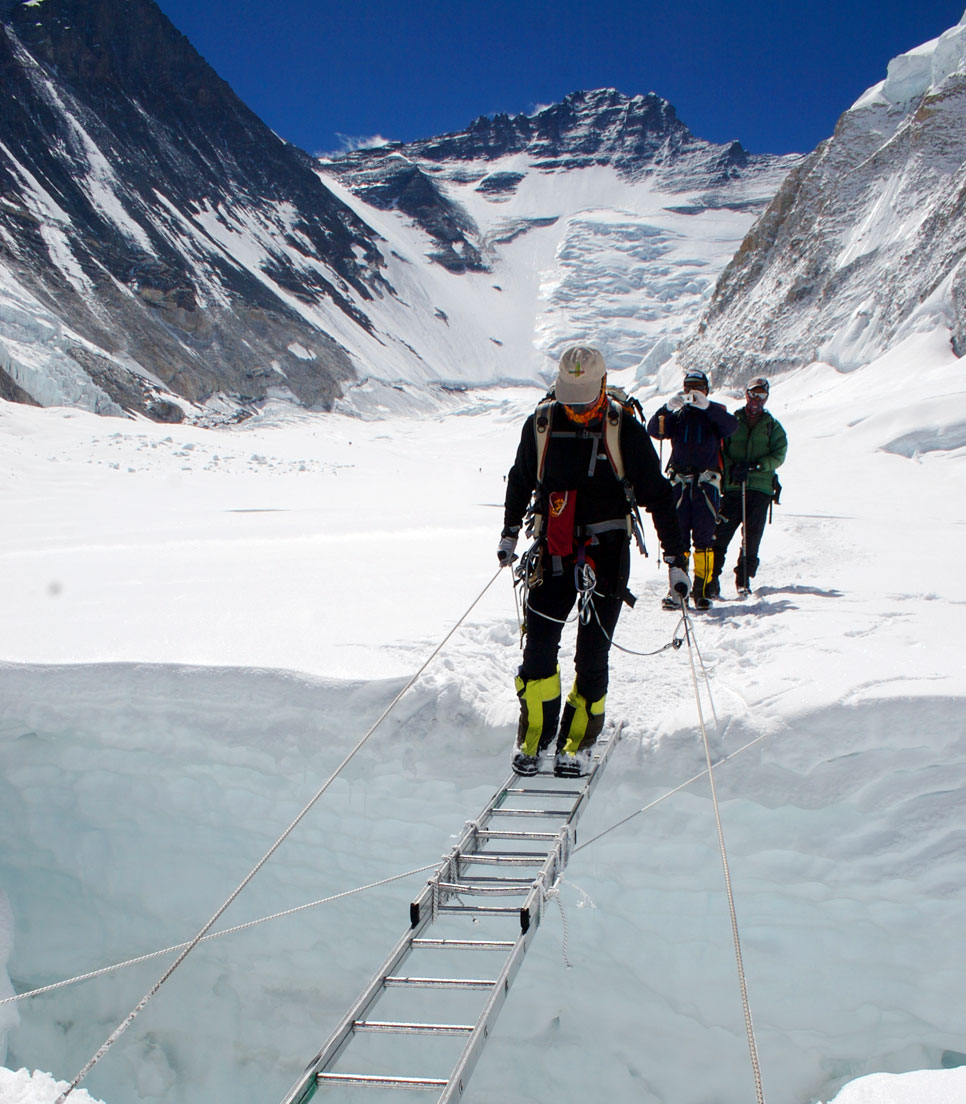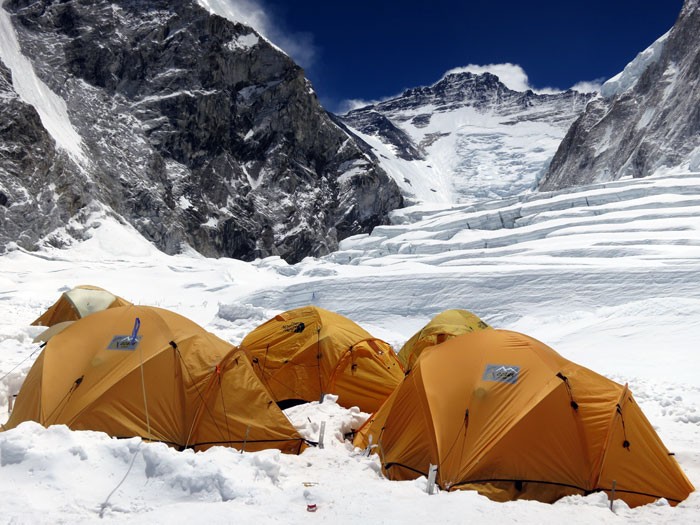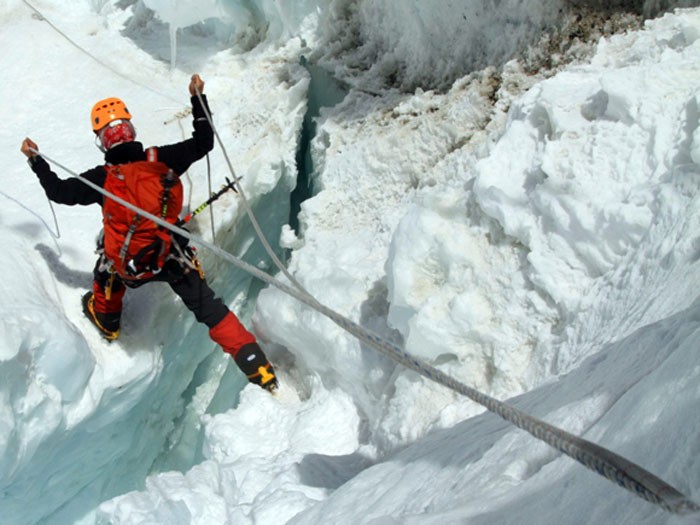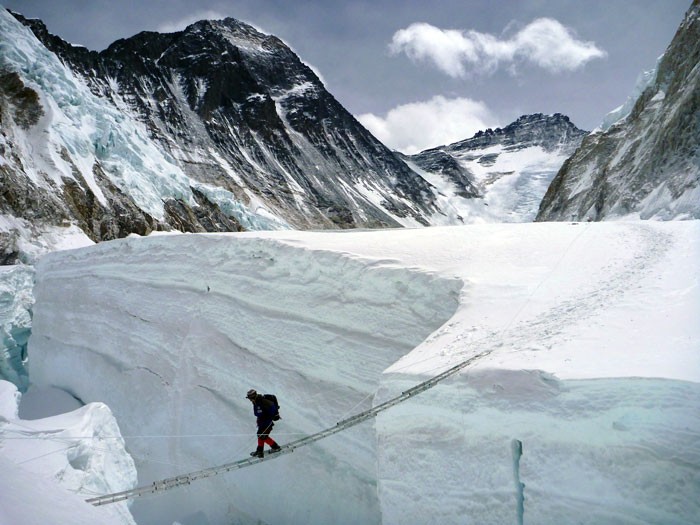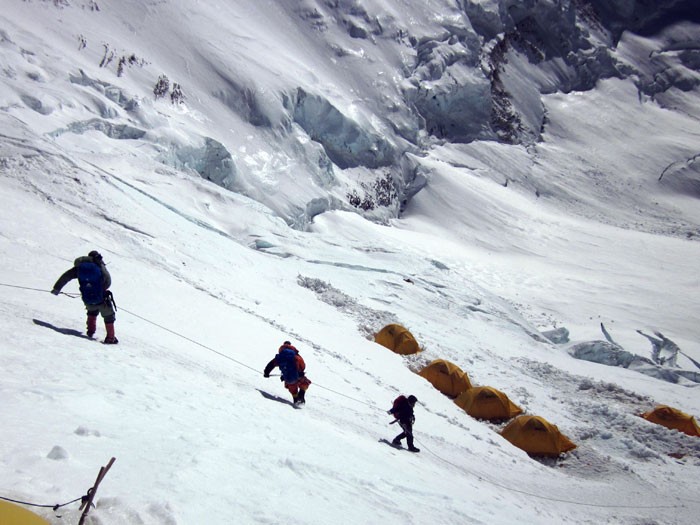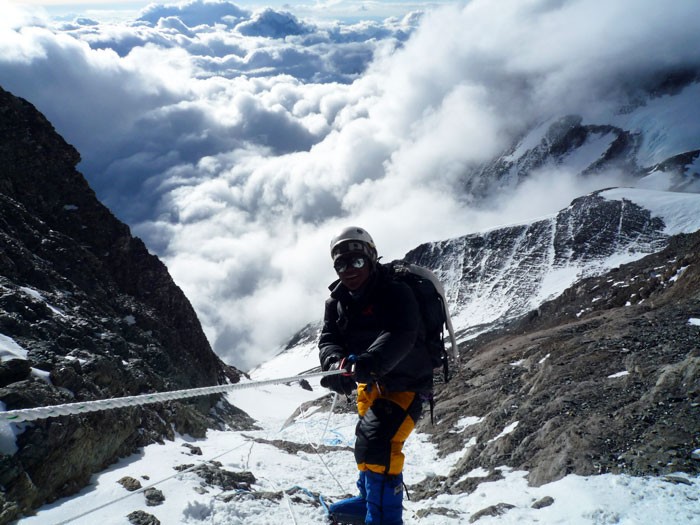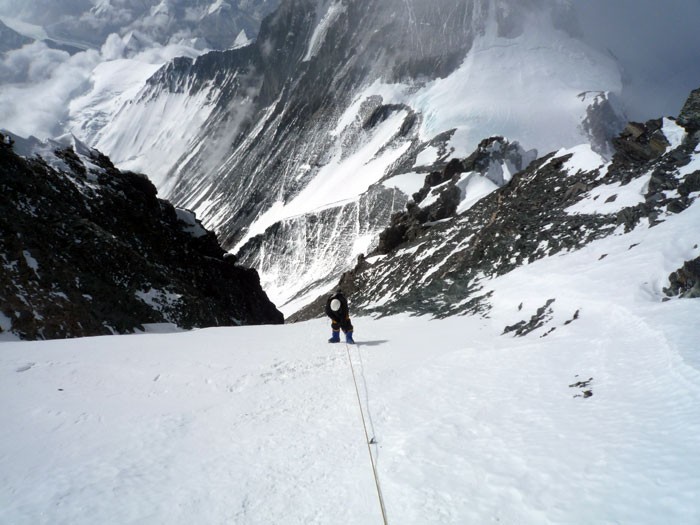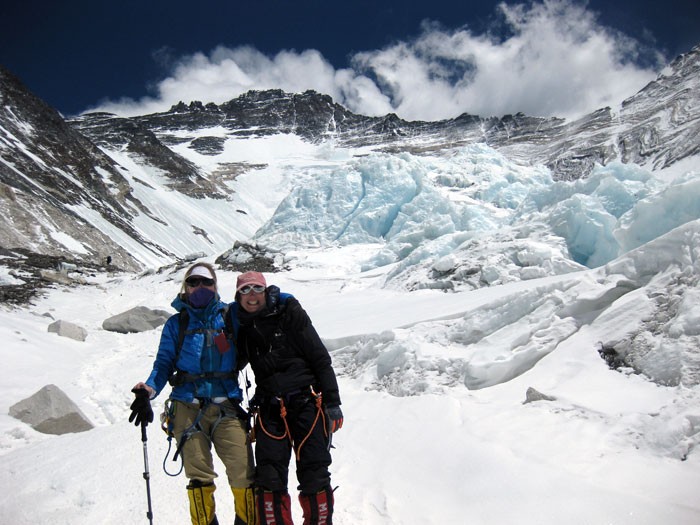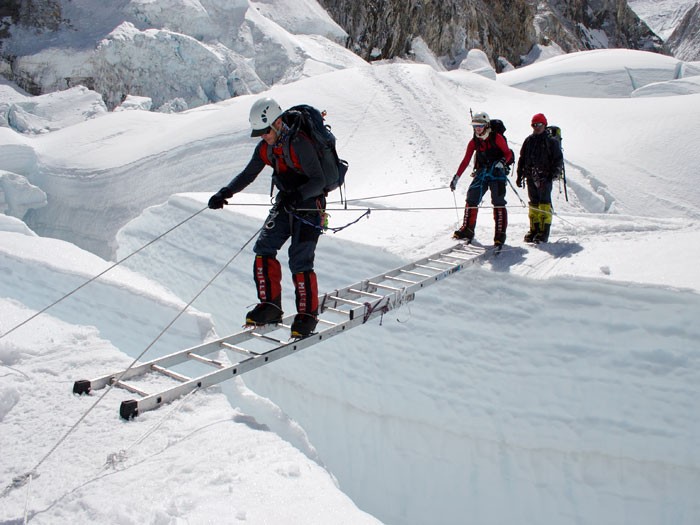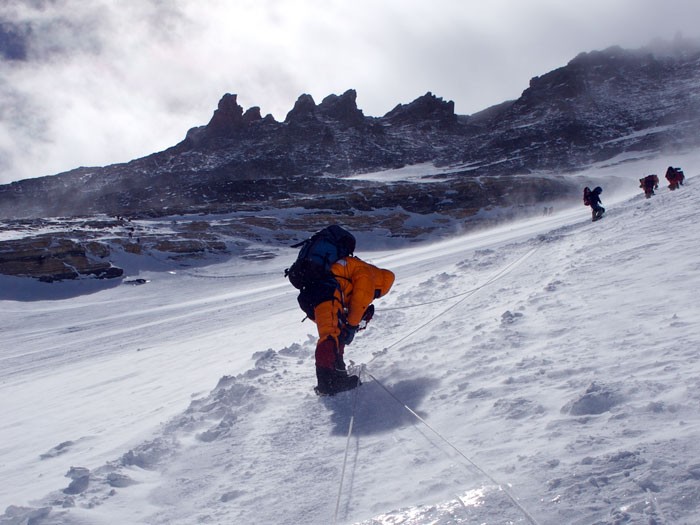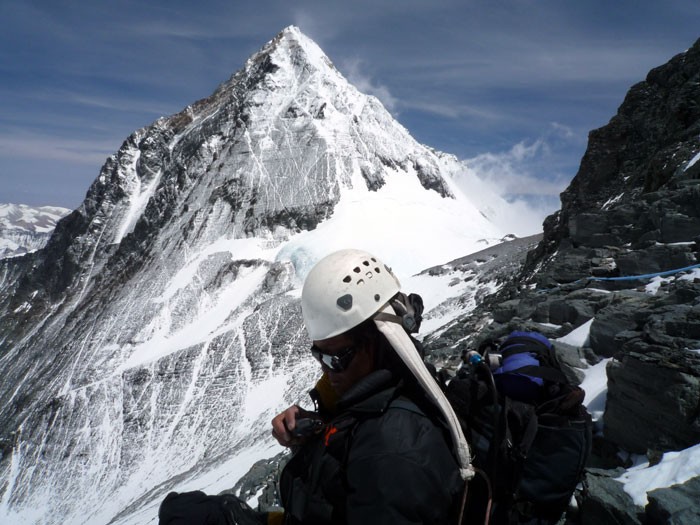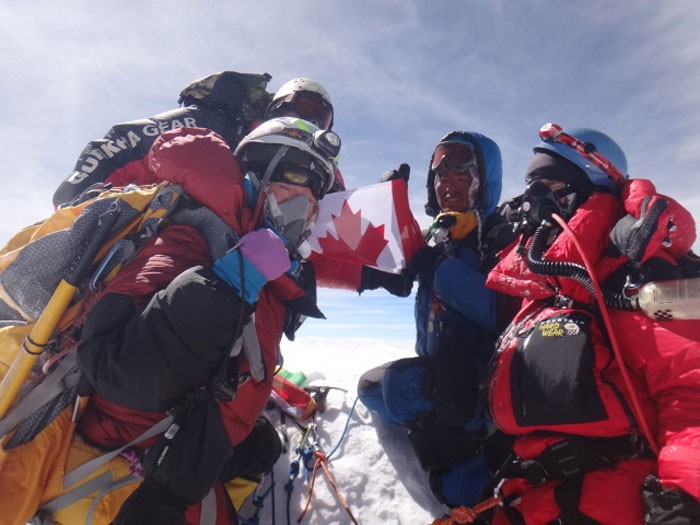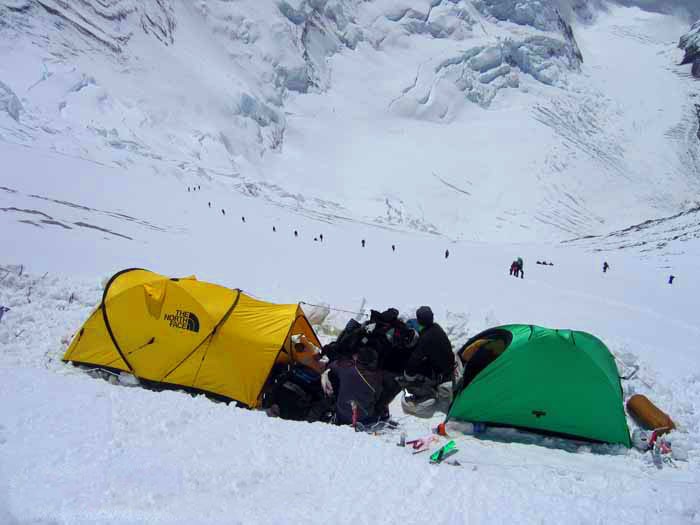Lhotse Expedition – Nepal
Lhotse Expedition – Nepal
Dates: 8 April to 6 June 2024 & 6 April to 4 June 2025
Spring Full Service Cost: $18,450, £14,850, €17,050 (fixed in USD)
Now offering Everest/Lhotse combination climb; two 8000m peaks in one expedition $53,450, £42,950, €49,450
Climb the world's 4th highest peak by the same route as Mount Everest, but at a much lower cost. Climbing Mount Lhotse is the best possible preparation for climbing Mount Everest.
Experienced leaders: Dan Mazur and Don Wargowsky from UK and USA have lead 3 successful Lhotse summits and 12 Everest summits. They are friendly, good teachers, and well organized.
Climb Everest and Lhotse together; two 8000m peaks in one trip. Call for details. Recent News: Please click here to view news of our expedition.
Lhotse is the fourth highest mountain in the world at 8,516 metres (27,940 feet), and is unique in that it is climbed from virtually the same route as Mount Everest.The route to camp 4 is the same as that of Tenzing and Hillary's first ascent route of Everest in 1953, and the dates we have chosen feature the best weather of the year. Join our team on one of the most beautiful and iconic climbs anywhere in the world!
Our full-service expedition includes:
- British, European, or American leader
- Expert climbing Sherpa
- Five bottle set of oxygen
- Transport to base camp to/from Kathmandu, including accommodation and domestic flights
- Yak transport of all equipment from Lukla to and from basecamp
- Skillful base camp cooks
- Three meals each day
- Group emergency equipment and satellite phone
- Full base camp with dinning tent, showers, bathroom, and solar charger
- Private tents in basecamp (no sharing)
- Double occupancy tents above base camp
- All permit fees and liaison officers
- Use of group gear and supplies
- Two nights stay in a clean comfortable conveniently located Kathmandu hotel on arrival and two nights prior to departure in a double room. Private rooms are available for a small additional fee.
- Airport transfer
What is not included?
- International flights to/from Kathmandu
- Mountain climbing rescue and travel insurance
- Personal climbing equipment and clothing
- Extra Oxygen (available on request)
- Gratuities for staff
- Nepalese visa
Our basic climb includes:
- All permit fees and liaison officer
- 5 bottle set of oxygen, mask, hoses, and regulator (More oxygen available on request)
- Basecamp meals; basecamp sleeping tent, basecamp dining tent, and tables and chairs
- Transport to base camp to/from Kathmandu, for you and personal equipment only (boots, ice axe, clothing, sleeping bag), including accommodation and meals on the road
- A walkie-talkie radio
- Emergency equipment and supplies
- Access to team fixed ropes and camps (sites, not tents)
- Airport transfers
- Two nights stay in a Kathmandu hotel on arrival and two nights prior to departure in a double room. Private rooms are available for a small additional fee.
- Other services and may be purchased and hired at minimal expense
Add on High Attitude Support : Click here for prices
- Private Sherpa (personal guide/porter) – Carries up to 10 kg (22bs) of your personal equipment, climbs with you, helps with clipping and unclipping from the fixed lines at each anchor, and will be with you every step of the way.
- Personal equipment carriage service – Sherpa carry up to 10kg (22lbs) of personal equipment up and down the mountain between camps
2) Orientation meeting, checking of your climbing gear and guided shopping to buy last minute supplies, visit temples, and tour the city. Stay at hotel.
3) Fly to Lukla, 2860 metres (9,385 feet). Walk to Phakding 2650 metres (8,695 feet). Stay in Teahouse.
4) Walk to Namche Bazaar, 3450 metres (11,320 feet). Teahouse.
5) Rest day with acclimatization hike to Everest View Hotel in Namche. Teahouse.
6) Walk to Pangboche, 3750 metres (12,300 feet). Participate in a Buddhist Puja blessing ceremony with the local Lama at the monastery if you wish. Teahouse.
7) Walk to Dingboche, 4410 metres (14,470 feet). Teahouse.
8) Acclimatization walk in Dingboche to 5000 metres (16,400 feet), return to Dingboche.
9) Walk to Lobuche, 4900 metres (16,075 feet). Teahouse.
10) Walk to basecamp, 5340 metres (17,400 feet). Camping
11) Rest, organization, and climbing gear checking in basecamp.
12) Ice training on the seracs of the Khumbu Glacier in basecamp.
13) Walk to Pumori advanced basecamp, 5800 metres (19,000 feet). Sleep there.
14) Rest in basecamp
15) Climb to camp 1 at 6100 meters (20,010 feet). Sleep at camp 1.
16) Rest in Camp 1
17) Walk partway to Camp 2. Return to camp 1. Sleep at camp 1
18) Climb to camp 2 at 6600 metres (21,500 feet). Sleep there.
19) Rest in Camp 2
20) Rest in Camp 2. Walk to the base of the Lhotse Face and return to camp 2. Sleep in Camp 2.
21) Rest in Camp 2
22) Climb to camp 3 at 7300 metres (23,950 feet). Sleep in Camp 3
23) Walk/Climb down to camp 2. Sleep in Camp 2
24) Walk down to basecamp
25) Rest in basecamp.
26) Rest in basecamp.
27) Descend to a lower village such as Pangboche at 3750 metres (12,300 feet). Or rest in basecamp.
28) Rest in lower village. Or rest in basecamp.
29-39) Rest in lower village and wait for the summit window. Or rest in basecamp.
40) Return to basecamp from lower village. Or rest in basecamp.
41) Return to basecamp from lower village. Or rest in basecamp.
42) Rest in basecamp. Wait for summit window.
43) Rest in basecamp. Wait for summit window.
44) Climb to camp 2, sleep there.
45) Rest in Camp 2
46) Climb to camp 3, sleep there.
47) Climb to camp 4, sleep there.
48) Attempt summit.
49) Extra day for summit attempt
50) Return to camp 2.
51) Return to basecamp.
52) Pack up basecamp.
53) Trek down to Pheriche. Teahouse.
54) Trek down to Pangboche. Teahouse.
55) Trek to Namche. Teahouse.
56) Trek to Lukla. Teahouse.
57) Flight from Lukla to Kathmandu. Stay at hotel.
58) Extra day for Lukla flight to Kathmandu. Stay at hotel.
59) Extra day in Kathmandu, in case of delay, and for sightseeing, gift shopping. Hotel.
60) Fly Home. Thanks for joining our expedition!
Leadership: Dan Mazur and Don Wargowsky are relaxed, friendly, well organized, and highly skilled professional with over 30 years combined experience leading people to the summits of mountains such as Everest, Lhotse, K2, Broad Peak, Gasherbrum, Cho Oyu, Lhotse, Manaslu, Shishapangma, AmaDablam, and Baruntse
Sherpas: We employ some of Nepal, Tibet, and the Karakorum’s best local mountaineers and Sherpas to assist team members in realizing their summit goals. Our friendly and loyal high altitude climbing staff has supported teams to the summits of more than ten of the highest peaks in the Himalaya.
Climbing:
- Climbing harness
- 5 meters (16 ft.) of 6mm accessory cord
- Figure 8 abseil/belay device (tube style devices, i.e. ATC will not work on fixed lines)
- Full size ascender (i.e. PetzlAscention)
- 2 locking carabiners, 1 large and 1 small
- 4 non-locking carabiners
- Ice axe with leash
- Steel crampons with anti-balling plates
- Trekking poles
- Abseiling/Rappelling Gloves
Upper Body:
- 2 cotton t-shirts
- 2 synthetic t-shirts
- 2 long sleeve synthetic shirts
- Light-weight soft shell jacket
- Medium weight insulatingjacket (fleece, down, or synthetic)
- Hard shell jacket with hood, waterproof and breathable (Gore-Tex or similar)
- Heavy down coat
- For 6,000m peaks a very warm down coat with hood or an 8,000m coat with hood
- For 7,000m peaks an 8,000m coat with hood
- For 8,000m peaks an 8,000m down coat with hood or an 8,000m suit can be used instead
Hands:
- Lightweight poly-liner gloves
- Mid-weight soft shell gloves – water/wind resistant
- Heavy- weight waterproof gloves – Gore-tex shell with removable liner
- Expedition weight mittens -Gore-tex over mitt matched polar fleece mitt liner
Head:
- Helmet
- Warm hat that covers your ears
- Balaclava
- Face mask
- Baseball hat or brimmed sun hat
- Glacier sunglasses with side shields
- Ski goggles with light and dark lenses
- Glasses with clear lenses to protect your eyes while climbing to the summit on windy nights. (cost less than 10 dollars in Kathmandu)
- Headlamp with extra batteries and bulbs
- Buff/neck gaiter
- Bandana or head scarf (optional)
Lower Body:
- Synthetic underwear
- Hiking shorts
- Hiking pants
- 2 pair lightweight thermal bottoms
- Medium or expedition weight thermal bottoms
- Polar fleece or soft shell pants
- Waterproof/breathable pants with full side zips (Gore-Tex or similar)
- Heavy insulating pants
- For 6,000m peaks: Down or synthetic pants will full zips
- For 7,000m peaks: 8,000m down pants
- For 8,000m peaks: 8,000m down pants or a 8,000m suit can be used instead
Feet:
- Boots
- For 6,000m peaks: Plastic or composite double boots (Koflach, La SportivaSpantik, etc) Modern waterproof, single boots designed for 4-5,000m peaks may be suitable if they can be worn with 2 pairs of socks and vapor barrier lines and/or they are equipped with overboots
- For 7,000m: Plastic or composite double boots (Koflach, La SportivaSpantik, etc)
- For 8,000m peaks: 8,000m boots - One-Sport Millet Everest boots or equivalent
- Sturdy leather walking boots
- Trainers, running shoes and/or sandals
- Down booties (optional)
- 3 pair med-heavy poly or wool socks
- 2 pair poly or wool liner socks (optional)
- Vapor barrier liner socks (optional)
- 2 pair lightweight trekking socks
- Cotton socks for in town
Sleeping:
- Down sleeping bag
- For 6,000m peaks: -18C or 0F
- For 7,000m peaks:-23C or -10F (If you sleep cold consider -29C or -20F)
- For 8,000m peaks: -29C or -20F (If you sleep cold consider -40C or -40F)
- An additional down sleeping bag for basecamp for the following climbs: Everest, Lhotse, AmaDablam, Manaslu, Cho Oyu, Shishapangma, Broad Peak, K2, Gasherbrum I and II, Spantik, K2/Broad Peak Everest training climb. For Mastagata a second sleeping bag is optional, but highly recommended.
- Down base camp sleeping bag should be rated to -10C or 15F (If you sleep cold consider -18C or 0F)
- Down base camp sleeping bag should be rated to -10C or 15F (If you sleep cold consider -18C or 0F)
- 2 closed cell foam kari-mats (sleeping pads) for use in basecamp and high altitude (these can be purchased inexpensively in Kathmandu)
- High quality inflatable sleeping pad designed for cold weather (Thermarest)
- Patch kit for inflatable pad
Rucksack and Travel Bags:
- Medium rucksack/backpack (50-70 litres / 3000-4500 cubic inches, can be used as carry-on bag)
- Waterproof rucksack cover (optional)
- 2 large (120+ L / 7500+ cubic inch) duffle kit bags for clothing and equipment
- Small luggage locks for duffel kit bags
Personal Hygiene:
- Female or male hygiene supplies
- 2 tubes lip sun cream
- Large tube skin sun cream (min factor 30)
- Anti-mosquito cream
- Toothpaste/brush
- Hand sanitizer gel (small-medium bottle)
- Bar of soap small towel
- Hand wipes
- Face Mask
- Hand sanitiser
- Disposable gloves
- Disinfectant wipes
Medical:
- Small personal first-aid kit. (Simple and Light) Aspirin, first-aid tape, plasters (band-aids), personal medications, etc.
- Blister repair kit
- 10 anti-diarrhea pills
- 20 anti-headache pills
- 10 cough and/or cold medicine
- Anti-altitude sickness pills: Diamox, Acetylzolamide
- 10 Stomach antibiotics: Ciprofloxacin, etc.
- 5 Azithromycin tables
- Steri pen or bottle of water purification tablets
- Cough sweets/lozenges (Halls/Stepils)
- Earplugs
- Extra prescription glasses/contact lenses and supplies
Personal Food:
- Snack food/daily energy food
- Everest training Nepal/Tibet, AmaDablam, Baruntse: 2-4kg (4.5-9lbs)
- Spantik, Cho Oyu, Shishapangma, Mustagata, Manasu: 2-5kg (4.5-11lbs)
- Broad Peak, K2, Gasherbrum I/II, K2/Everest training, Everest, Lhotse: 3-6kg (6.5-13lbs)
- Dehydrated meals (freeze-dried dinners) for summit attempt
- Everest training Nepal/Tibet, AmaDablam: 2 meals
- Spantik, Cho Oyu, Shishapangma, Mustagata, Manasu, Baruntse: 3 meals
- Broad Peak, K2, Gasherbrum I/II, K2/Everest training, Everest, Lhotse: 5 meals
- Small roll of repair tape
- Sewing repair kit
- Cigarette lighter
- Small box matches
- Compass or GPS
- Battery powered alarm clock/watch
- Camera with extra cards and extra batteries
- Nylon stuff sacks for food and gear storage
- 2 water bottles (1 litre) wide-mouth Nalgene
- Pee bottle (1litre or larger)
- Plastic cup and spoon
- Small folding knife
- Binoculars (optional)
- 4 large, waterproof, disposable rubbish sacks
- Passport, 2 extra passport photos, flight ticket, flight itinerary
- Separate photocopies of passport and relevant visa pages, proof of insurance
- Dollars, pounds, or euros cash
- Bank/ATM/Cash and credit cards
- Bathing suit/swim suit (you never know)
- Paperback books, playing cards, ipod/mp3 player, musical instruments, extra batteries, etc.
- Travel clothes for basecamp and in town
- Umbrella (optional)
- Small solar panels for personal electronics (optional)
Group Equipment:
We provide group gear, equipment, and supplies including: rope, ice, rock, and snow anchor protection, tents; stoves, fuel, walkie-talkie radios, bamboo marker wands, etcetera. A personal tent will be provided for each member at base camp. On the upper mountain, team members will share tents. In base camp, a shower, toilet, solar charger, and a dining tent will be provided.
Please fill out an application and return it to us with your refundable ten-percent deposit to hold your place on the team.
- Application for US Team Members : PDF Form or MS Word Doc
- Application for all other Team Members : PDF Form or MS Word Doc
In addition to your application, we will need the following at least two months before the trip begins:
- Completed Payment
- Oxygen order (if any)
- Sherpa order (if any)
- Trip Registration form
- 1 Passport sized photo
- A scan of your passport identification pages
- Complete flight itinerary
- Proof of travel, accident, and repatriation insurance. We strongly recommend Global Rescue, with at least $50,000 worth of helicopter rescue insurance.
- Trip cancellation/interruption insurance is recommended
Please contact us with any questions you may have.
